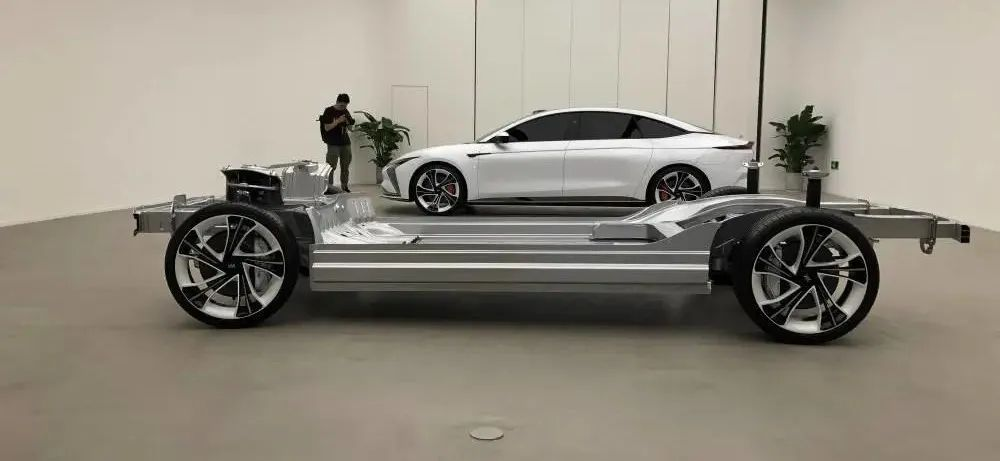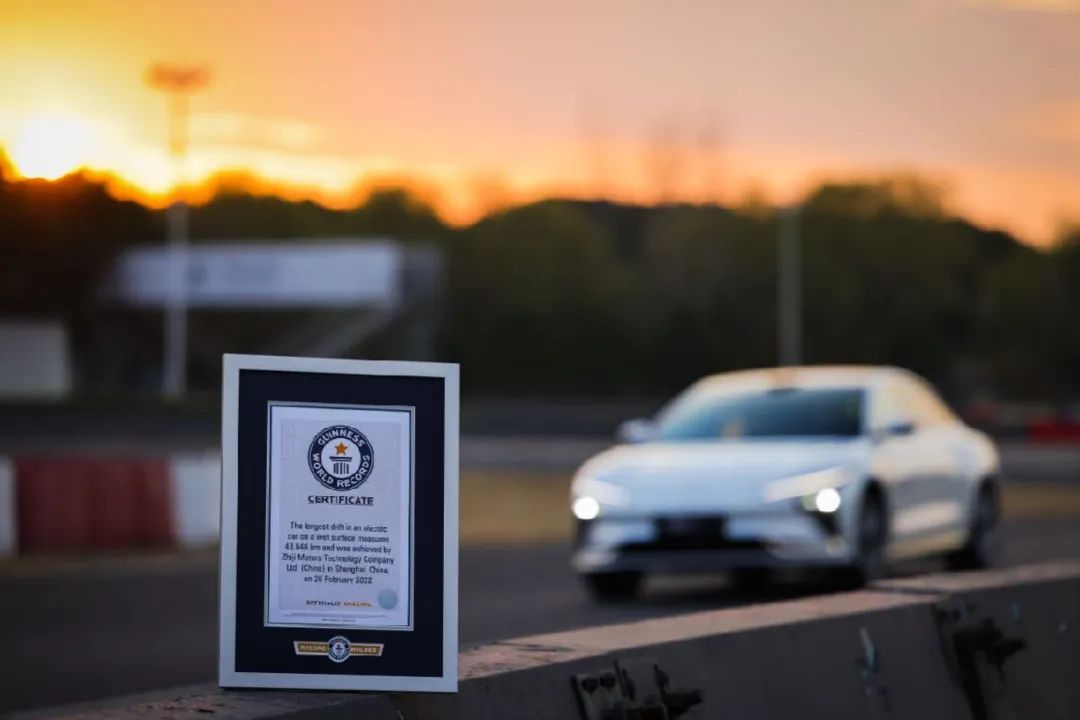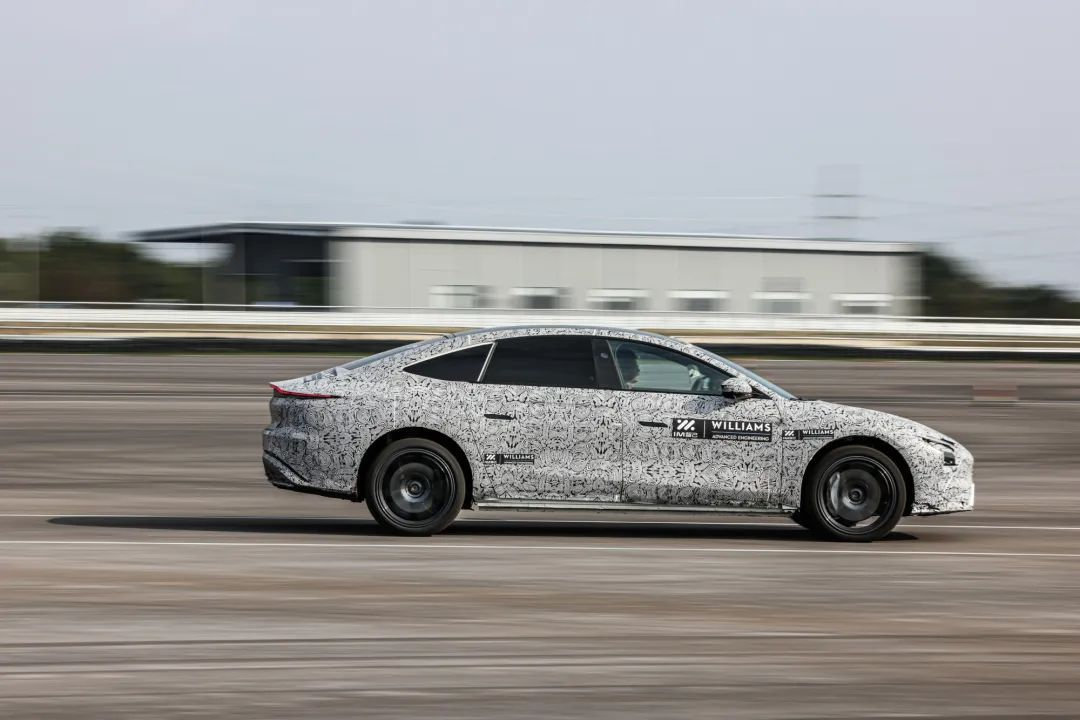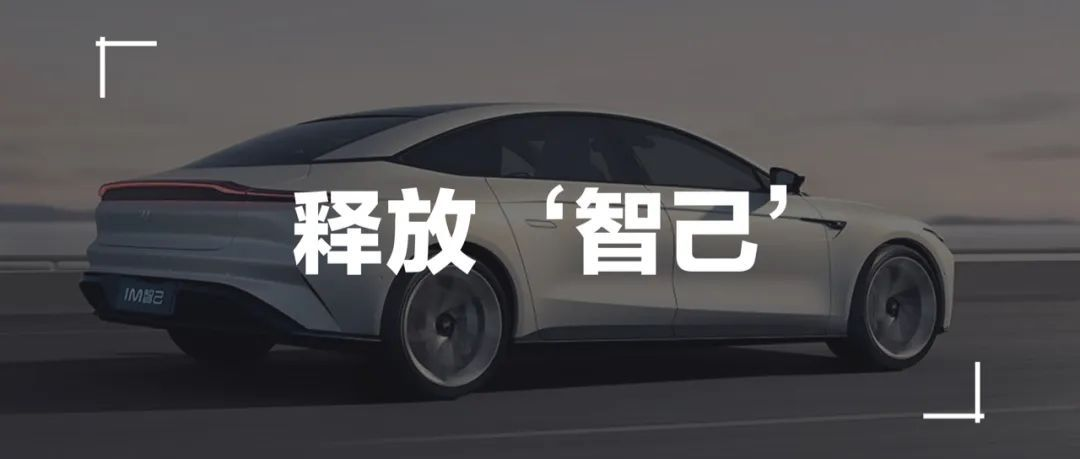On the evening of April 17th, with a strongly emotional live broadcasted release event, IM officially announced the launch of its L7 model, with a price range of 368,800 to 408,800 yuan. It is likely to become the strongest player in the “large cars” category of over 5 meters, perhaps second to none.
In addition to the stunning price, there was also a challenge that caught people’s attention during the release event. Most of the time, a white IM L7 alone would be seen drifting and circling on the slippery ground in the small box on the bottom right corner of the screen, reminding one of the little flag that spun on its own for more than four hours and over 8,000 circles during the 2014 CCTV Spring Festival Gala.
As they say, “one minute on stage, ten years of practice offstage.” What kind of skills has this medium-sized luxury electric car mastered after drifting continuously for 66 minutes and 43.646 km?
Challenging the Doughnut – How Difficult Can It Be?
For practitioners, the purpose is often the core pursuit. Martial arts are practiced to strengthen the body and for self-defense, while dance is done to enhance flexibility and grace. If one were to ask why IM is so determined to become the “king of electric drifting,” there may only be one answer: “To showcase just how superb the driving performance of an electric car can be to the world.”
Before the IM L7, the first brands or products that came to mind when people talked about electric cars that focused on driving performance were often Tesla, NIO, and Porsche Taycan.
As a masterpiece of traditional sports car manufacturers’ electrification transformation, The Taycan became the new growth pole of Porsche, not only due to its 800V DC fast charging, and the illumination of the super-luxury brand halo but also due to a 55-minute, 42.171 km continuous drift world record.
The direct result of this challenge was to dispel the doubts of petrol heads who questioned Porsche’s ability to maintain excellent driving performance with electric cars and convince the new car owners who were hesitant about electrification to embrace Stuttgart’s electrification efforts as a powerful new ally.
In the eyes of those who truly understand cars, what seems like a dull and monotonous depiction of doughnuts using tires, is actually a very rigorous performance test.
As a driving art, drifting is a test of whether a car’s chassis, power, steering, and durability can be accurately controlled in a narrow, fuzzy gap between safety and danger. It provides highly focused drivers with accurate dynamic feedback, so that they can sustainably and carefully slide their cars over time.
To achieve this goal, the car must satisfy a strict requirement: “high horsepower rear-wheel drive.”
The logic is simple: more power directed towards the rear wheels, along with high horsepower that causes the tires to spin, can maintain the saturation of lateral force on the rear wheels and enter the blurry boundary of danger by using dynamic friction.
At this point, inputting a reverse turning angle and applying a lateral motion deviation angle through wheel-end power distribution can begin to control the lateral stability of the car body.
Generally speaking, the lower the center of gravity, the smaller the tilt angle, the better the balance of the car body posture, the more uniform the wheel-end power distribution, and the easier it is to maintain the drift.
However, in the world of electric cars, the situation has not become simpler with quieter and stronger electric motors. On the contrary, due to the greater weight and the lack of sound feedback, drivers rely more on body feedback to perceive dynamic changes, thus invisibly increasing the requirement for driving skills.
Compared to the subjective judgments of car reviewers, people are more interested in experiencing a car’s driving performance intuitively, even hoping to see exciting scenes of “knocking out the old master with a flurry of punches.” Breaking a world record with continuous drifting is an excellent opportunity to prove one’s “intelligence.”
Technological innovation, master empowerment, and achieving a win-win outcome by resolving conflicts
The opportunity is at hand, but the journey of overcoming challenges is still far away. After all, making a car that is 5,098 mm long with a wheelbase of 3,100 mm break the world record set by a smaller-sized Taycan requires engineers to seek flexibility and stability, which seem to be conflicting in terms of car size.
At the same time, a weight of 2,290 kg needs to be balanced as evenly as possible through sophisticated structural design, fully tapping into the advantage of a low center of gravity brought by battery layout, in order to offset the turning tilt caused by annoying inertia transfer.
In the face of these seemingly difficult physical problems, “intelligence” provides a simple and rough answer, which can be summarized as “maximizing hardware performance and tuning by masters.”

Intelligence L7 is built on iO “Origin” high-end pure electric architecture that is developed entirely in a positive direction. It adopts a “double ball joint double wishbone front suspension + all external ball joint five-link rear suspension structure,” achieving perfect weight distribution of 50:50 front and rear.
This not only brings linear steady-state balance but also maintains nonlinear transient balance, making the communication between man and car smoother and more harmonious.To enable drivers to more intuitively feel the dynamics of the chassis, not only does the driving position need to stay as close to the ground as possible, but the overall center of gravity also needs to be sufficiently low. In addition to making focused efforts on the chassis, the design of the 93 kWh battery pack also needs to align with engineering goals.
As such, Zeekr started from the battery structure and cell layout and introduced the industry’s first mass-produced horizontal cell solution. By laying flat the vertically arranged cells and stacking them, the design freedom in the Z-axis direction was greatly improved, and the horizontal venting of the cell explosion valve helped alleviate the pressure on the upper cover, resulting in a battery thickness of 125 mm.
This not only allowed the Zeekr L7 to achieve a super-low center of gravity of 490 mm, but also took into account the headroom performance of the occupants while keeping the ground clearance unaffected.
Similar forward-looking R&D logic can also be found in Zeekr L7’s standard four-wheel electric vector drive technology.
Here, “vector” refers to ZF’s second-generation AKC rear-wheel steering system, which can achieve a maximum of 12 degrees of both-way steering. When driving at a speed of less than 40km/h, the rear wheels will turn in the opposite direction and the turning radius of 5.4 m is equivalent to that of a small car with a wheelbase of 2580 mm. Conversely, when driving at a speed higher than 40km/h, the rear wheels will turn in the same direction, and the high-speed stability is equivalent to that of a large sedan with a wheelbase of 3250 mm. This ultimately achieves the wonderful compatibility of low-speed agility and high-speed stability.
In order to achieve the rear-wheel drive power characteristic, the power of the rear axle black label motor is significantly greater than that of the front axle at 250 kW vs 175 kW respectively, and it uses an 8-layer hairpin flat wire winding and magnesium alloy housing, with a power density of 3.03 kW/kg that is unrivaled on the 400V voltage platform.
The direct waterfall-type oil cooling also brings better peak continuous performance, supporting over 10 extreme accelerations, with power output delivered instantly and without the need for skill cooling.
With these hardware equipment armed to the teeth, Zeekr invited the experienced development team of Williams Advanced Engineering to empower it, and as a “technology partner,” carried out extremely stringent chassis tuning and validation.At the largest Millbrook test track in the UK, Williams optimized 108 performance indicators such as braking, ride comfort, high-speed stability, acceleration/braking attitude control, roll control, precision, and steering force, and ultimately achieved a driving experience that brings both driving pleasure and riding comfort.

To ensure success, IM also cultivated a dedicated “driver team.” Eventually, Panda, driver number 0, overcame a 66-minute physical and mental challenge, breaking the record for the longest drift distance for an electric car of 43.646 kilometers, previously set by Taycan, making IM L7 the new “drift king” as they intended, and bringing a successful conclusion to the performance feast of this press conference.
New Forces Breakthrough: Who will be the luxury electric car winner?
After the joy of the successful challenge gradually faded, it was time to return to rational market choices. Although IM L7 has proved its performance strength with a new world record, it is not a lone player in the world of luxury electric vehicles, especially with its most potent opponent, NIO ET7, which began delivery several days prior.

Both names include 7, both are considered high-end intelligent pure electric vehicles, and they are both mid-size to large sedans. However, thanks to its ultra-thin battery pack, IM L7 has a more elongated and streamlined side profile, that features headroom and a higher body that is equivalent to ET7. Nevertheless, NIO ET7 needs to rely on its slightly raised back design to ease the problem of the higher visual center of gravity.

In terms of power parameters, although IM L7’s 425 kW, 725 N·m is inferior to the ET7’s 480 kW, 850 N·m, the difference in zero-to-100 km/h acceleration time between the two is within a hair’s breadth, making IM L7’s power output more efficient. But no matter how you compare it, breaking 100 km/h within 4 seconds is enough to satisfy the performance demands of most people.
However, range is the place where IM L7 falls short, with a 615 km range from a 93 kWh battery, which is behind the 675 km range of the 100 kWh version of the NIO ET7 (CLTC mode). But given the price difference of at least one hundred thousand yuan, the 60 km gap may not make people so anxious.
As for the smart cabin that new forces are making waves, the two models naturally use different ways to stand out.The IM L7 adopts a three-screen lift system, consisting of a 26.3-inch main screen, a 12.3-inch co-pilot entertainment screen, and a 12.8-inch 2K central control touch screen. The main and co-pilot entertainment screens can be lifted separately, or lowered to half-screen in supercar mode, with simulated engine sound effects for a creative driving experience.
The NIO ET7, on the other hand, features a relatively conventional combination of a 10.2-inch LCD instrument panel and a 12.8-inch central control touch screen. However, NIO’s cabin system has already been validated by the market with their 886 three product lineup, along with a minimalistic interior design, making ET7 stand out from the traditional BBA approach of showcasing luxury with exaggerated materials.
In terms of advanced driving assistance systems, the IM L7’s IM AD intelligent driving system hardware includes 5 millimeter-wave radars, 12 ultrasonic radars, 11 HD cameras, 2 high-precision positioning units, and 2 LiDARs (upgrade option). The autonomous driving computing chip is the same as the XPeng P7’s NVIDIA Xavier chip, which, with the addition of LiDAR, can meet the needs of urban assistance driving, but the calculation power of Xavier is not sufficient for city NGP, as commented by Wu Xinzhou, the head of XPeng’s intelligent driving. Therefore, G9 has been upgraded to Orin.
Fortunately, IM car owners can upgrade to the Orin chip through the equity plan, and the data-driven technology route can use authorized driving data from users to significantly enhance the intelligent driving experience in all scenarios. It is really difficult to determine who is better in practice.
Starting at 360,000 yuan, the IM L7 has a wide range of configurations, as shown in an official image.
It is evident that the IM L7 is more inclined to showcase its uniqueness with solid efforts in a market that is becoming increasingly homogeneous. Its outstanding performance in driving control is undoubtedly aimed at consumers who still feel reluctant to give up the experience of driving gasoline vehicles. Compared with its competitors, the difference in style will naturally lead the IM L7 to target a different group of users. However, only time can tell who will achieve higher sales.
This article is a translation by ChatGPT of a Chinese report from 42HOW. If you have any questions about it, please email bd@42how.com.
